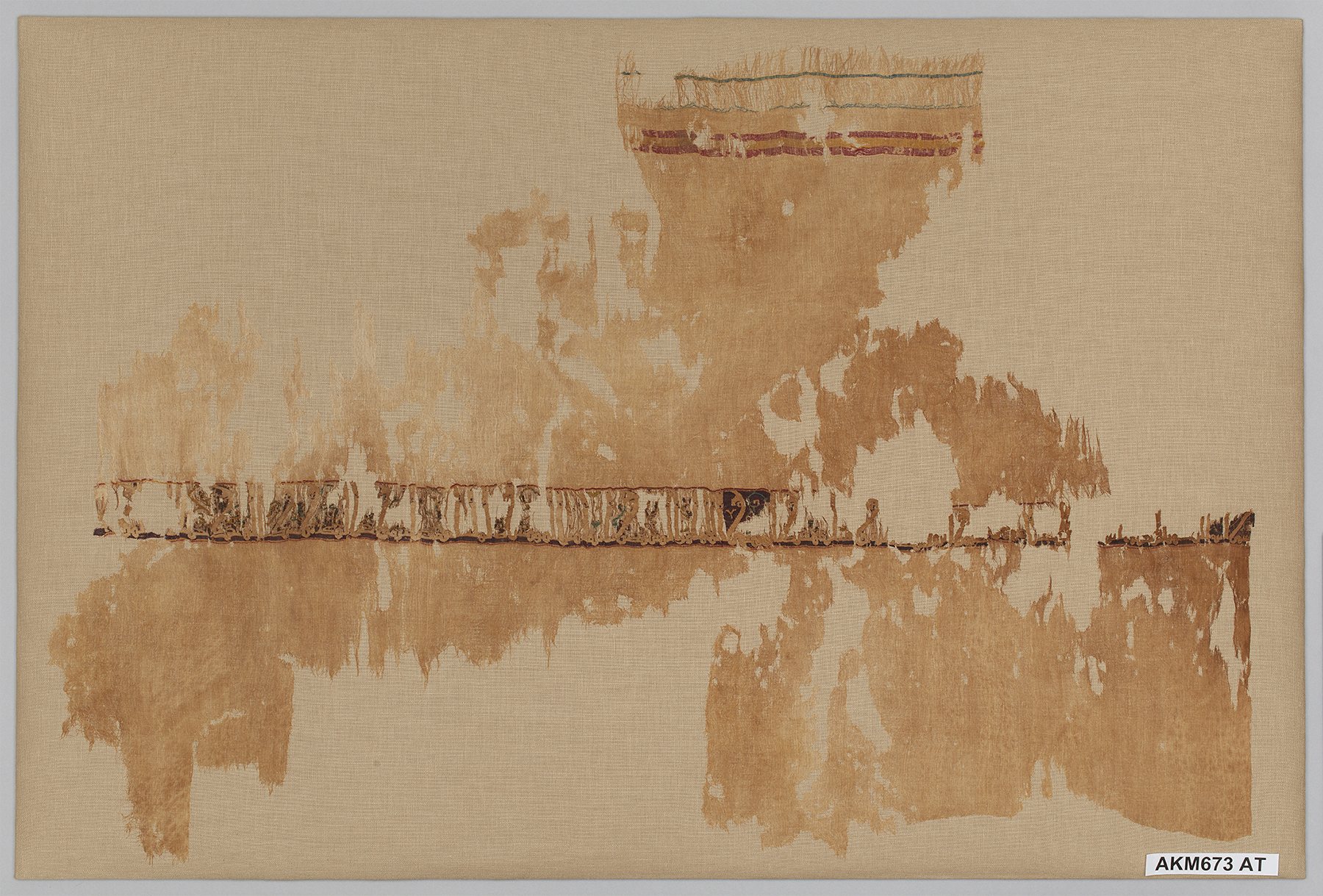Click on the image to zoom
Tiraz textile
- Accession Number:AKM673
- Place:Egypt
- Dimensions:82 x 57 cm
- Date:second half of 11th century
- Materials and Technique:linen tabby; with purple, yellow, and blue silk, and undyed linen tapestry-woven inscription
This linen textile with its regal purple inscription naming the Fatimid caliph al-Mustansir has lost much of it original length due to its use as a burial shroud. However, it preserves almost its full width, spanned by the decorative inscription band. Known as a “tiraz” textile, it is unusually wide and was perhaps a shawl (see AKM670 for more information about tiraz). The term “tiraz” actually means “embroidery,” but came to denote an inscription band as one sees on these textiles and on anything else, including architecture. Most of the medieval textiles discovered in excavations in Egypt had been used as burial shrouds and have suffered similar deterioration. Only those that found their way into European church treasuries are well preserved and give us an idea of how the full garment appeared. Tiraz textiles, despite their Arabic inscriptions, were highly valued in Europe as relics of the Holy Land and appear as the costumes of Christ and the Virgin in Italian Renaissance paintings.
Further Reading
There are many Traditions (hadith) related by the Companions of the Prophet that concern burial and the shroud. They emphasize the simplicity of the ritual, particularly with reference to the shroud (kafan). The model for the shroud is that which was used for the Prophet. According to one of the most famous recorders of Tradition, the Sahih al-Bukhari, a statement by the Prophet’s wife Aisha noted that he was shrouded in three pieces of cotton cloth that were not garments. [1]
Tiraz textiles were well-suited to meet these conditions. They were simple tabby weaves (the weft crossing over and under the warps, which were strung on the loom). They generally had little or no decoration other than an inscription band. This band usually invoked God’s blessings on the ruler and his family, as well as on the Prophet. Excavations of burials in Cairo reveal that the tiraz inscription was placed around the head, often covering the mouth. This may be explained through another Tradition of al-Bukhari. [2] It speaks of a man who fell from his camel and broke his neck. The Prophet commanded that he be bathed and shrouded with two pieces of cloth, keeping his head out of the shroud so that on the Day of Resurrection he could pronounce the appropriate prayers. As the tiraz band was placed over the mouth of the deceased, it was as if he himself were reciting it—in fulfillment of the Tradition.
Bordering the fringe at the top of this textile are two thin blue stripes that may have framed a tapestry band, the silk threads of which have disintegrated. Below this is a band of three stripes: red, yellow, and red. Across the centre of the fragment runs a beautiful Arabic inscription, tapestry-woven in undyed linen on a ground of purple. Blue and yellow tendrils decorate the ground between letters. The Kufic script is in a monumental style, with curving elements that go below the base-line, rising up to form graceful “swan’s necks.” The vertical staffs are tall and thin. The purple ground is edged by yellow and red wefts. The inscription is executed with great precision. A somewhat earlier tiraz textile in the Abegg Collection, woven at Tinnis and dated 995, has a similar style of Kufic, also with blue tendrils but on a red ground. [3] Like this textile from the Aga Khan Museum Collection, it has weft stripes below the fringe.
Inscription:
بسم الله الرحمن الرحيم ...نصر من الله لمعد ابي تميم الامام المستنصر بالله امير المؤ منين صلوت الله عليه و علي (ائمه الطاهرين المهديين؟) ومحمد خاتم النبيين
Translation:
In the name of God, the Beneficent, the Merciful; . . . victory from God to Maʻdd Abi Tamim, the Imam al-Mustanṣir Billah, Commander of the Faithful. Blessings from God upon him and upon the pure and guided Imams and on Muhammad, the Seal of the Prophets . . .
— Lisa Golombek
Notes
[1] Book #23, Hadith #361.
[2] Book #007, Hadith #2753.
[3] In the Abegg Collection (no. 14), K. Otavsky and M.A.M. Salim, Mittelalterliche Textilien (Riggisberg, Switzerland: Abegg-Stifftung, 1995), 45. ISBN: 3905014068
Note: This online resource is reviewed and updated on an ongoing basis. We are committed to improving this information and will revise and update knowledge about this object as it becomes available.


